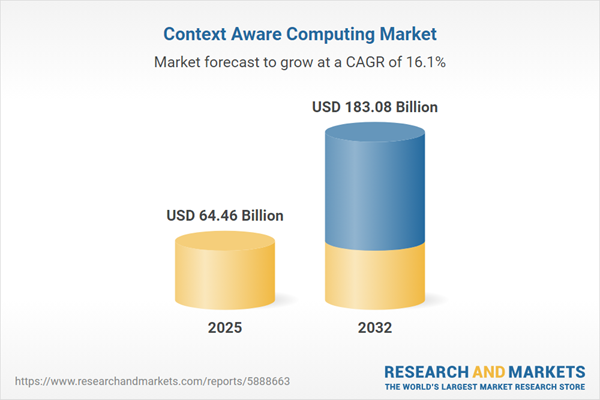Speak directly to the analyst to clarify any post sales queries you may have.
Context aware computing is driving a new era in enterprise technology, enabling more agile business strategies through real-time intelligence and adaptive decision-making. As senior leaders assess digital transformation priorities, these technologies provide the advanced capabilities needed to align operational processes with evolving organizational goals.
Market Snapshot: Context Aware Computing Market Outlook
The context aware computing market is advancing steadily, shaped by rapid adoption in sectors such as banking, healthcare, logistics, and manufacturing. Recent market growth has elevated its valuation from USD 55.34 billion to USD 64.46 billion, with analysts projecting it will reach USD 183.08 billion by 2032. A compound annual growth rate of 16.13% underscores strong momentum, supported by fast-paced sensor integration, rising use of advanced analytics, and expansion of connected enterprise devices. These factors empower organizations to deliver personalized customer touchpoints, boost the efficiency of vital operations, and reinforce business continuity—all while digital disruption reshapes their industries.
Scope & Segmentation of the Context Aware Computing Market
- Components: Gateways, sensors, tags, and wearables continuously deliver high-volume data, while middleware and analytics platforms transform these sources into actionable intelligence. Complementary consulting and technical services help guide successful deployments and support ongoing operational gains.
- Technologies: Bluetooth Low Energy, RFID, infrared, ultra wideband, ultrasound, and Wi-Fi provide the backbone for enterprise connectivity, supporting automation and seamless integration across business units.
- Applications: Context aware solutions enhance customer engagement through advanced advertising, improve clinical outcomes in healthcare monitoring, strengthen threat detection with security tools, and drive efficient just-in-time decision-making in asset tracking and location services.
- Industry Verticals: Banking, finance, education, retail, healthcare, logistics, manufacturing, and transportation are leveraging these technologies to promote process efficiency, support compliance, and deliver consistent service experiences in fast-changing environments.
- End Users: Both large enterprises and small to medium-sized businesses (SMBs) are adopting context aware computing to scale operations, streamline digital workflows, and align technology investments with broader business objectives.
- Regions: Adoption rates in the Americas, Europe, Asia-Pacific, and Middle East & Africa vary according to infrastructure, regulatory factors, and digital maturity. Regional nuances shape deployment strategies, driving tailored market approaches.
- Company Coverage: Leading players such as Microsoft, Amazon, Google, IBM, SAP, Cisco, and Oracle define market standards, driving advancements through innovation and best practice development.
Key Takeaways for Senior Decision-Makers
- Implementing context aware computing allows enterprises to reconfigure digital frameworks as business needs change, improving strategic agility without disrupting operations.
- Combining artificial intelligence with edge-based systems enhances decision accuracy and enables rapid, context-driven responses to shifting enterprise risks.
- Modular infrastructures, aligned with expert consulting, streamline compliance management and fortify risk control during complex digital transformation processes.
- Flexible technology choices support rapid adaptation to emerging challenges and synchronize IT initiatives with ongoing innovation pathways.
- Collaborating closely with supply and partner networks accelerates workflow efficiency and reinforces business continuity in interconnected, global operations.
- Emphasizing privacy protocols and ensuring interoperability increase stakeholder trust by safeguarding data and minimizing exposure to regulatory or operational breaches.
Tariff Impact on Supply Chains and Adoption
Recent U.S. tariffs have resulted in higher hardware expenses for context aware computing solutions. In response, many organizations are diversifying sourcing strategies by working with suppliers in Asia-Pacific and Europe to reduce potential cost pressures and mitigate geopolitical risks. Stronger regional partnerships with technology providers can accelerate solution deployment and improve alignment with local compliance requirements. Ongoing monitoring of trade policy developments is essential to safeguard supply chain resilience and support long-term market expansion.
Methodology & Data Sources
This analysis draws on direct interviews with senior executives, technical specialists, and enterprise architects. Findings are validated by reviewing industry research and relevant regulatory documents, ensuring each recommendation aligns with enterprise strategy and compliance needs.
Why This Report Matters
- Supplies actionable, well-researched guidance for strategic investments in context aware computing, focused on driving measurable business outcomes.
- Details regional trends and regulatory environments, helping leaders design agile frameworks that address sector-specific requirements and compliance standards.
- Provides expert-validated recommendations to support resilience, future-proofing digital initiatives as transformation accelerates across core operations.
Conclusion
Context aware computing is empowering enterprises with the tools for reliable, flexible digital transformation. With targeted insights, decision-makers can confidently respond to dynamic market needs and advance organizational progress in an ever-evolving digital landscape.
Additional Product Information:
- Purchase of this report includes 1 year online access with quarterly updates.
- This report can be updated on request. Please contact our Customer Experience team using the Ask a Question widget on our website.
Table of Contents
3. Executive Summary
4. Market Overview
7. Cumulative Impact of Artificial Intelligence 2025
Companies Mentioned
The companies profiled in this Context Aware Computing market report include:- Microsoft Corporation
- Amazon.com, Inc.
- Google LLC
- International Business Machines Corporation
- SAP SE
- Cisco Systems, Inc.
- Oracle Corporation
Table Information
| Report Attribute | Details |
|---|---|
| No. of Pages | 198 |
| Published | October 2025 |
| Forecast Period | 2025 - 2032 |
| Estimated Market Value ( USD | $ 64.46 Billion |
| Forecasted Market Value ( USD | $ 183.08 Billion |
| Compound Annual Growth Rate | 16.1% |
| Regions Covered | Global |
| No. of Companies Mentioned | 8 |









